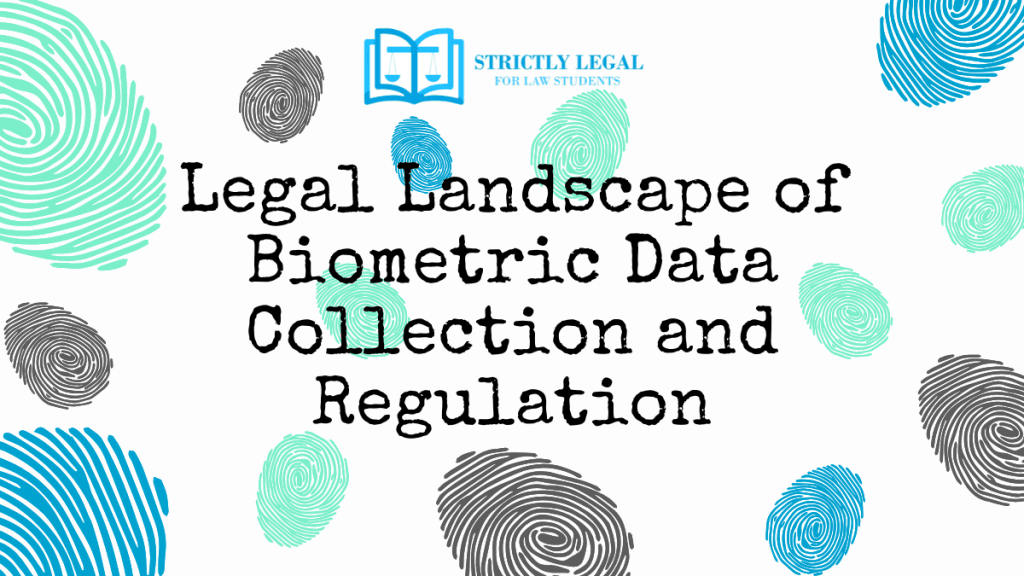In the modern digital age, biometric data collection has become an integral part of various industries, ranging from healthcare to finance, to enhance security and streamline processes. However, as biometric data—such as fingerprints, retina scans, and facial recognition—has become more widely used, concerns around privacy, data protection, and individual rights have surfaced. In India, the growing use of biometric data calls for a careful balance between technological advancement and the protection of individual privacy. This article explores the legal framework regulating biometric data collection and usage in India and the challenges it presents.
Table of Contents
What is Biometric Data?
Biometric data refers to unique biological characteristics of an individual, such as fingerprint scans, retina scans, facial recognition, voice patterns, DNA Profiles etc. These characteristics are used to identify, authenticate, and validate the identity of individuals, offering higher security and accuracy than traditional forms of identification. However, this very sensitivity and uniqueness of biometric data raise significant privacy and data protection concerns, especially when it comes to its collection, storage, and usage.
Legal Framework Regulating Biometric Data in India
India’s legal approach to biometric data regulation is still evolving, with several key frameworks that address data privacy and protection in the digital age. While there is no single law dedicated entirely to the regulation of biometric data, several pieces of legislation and guidelines govern its collection, use, and storage.
The Information Technology Act, 2000 (IT Act)
The Information Technology Act, 2000 is a key piece of legislation in India that governs electronic commerce, digital transactions, and information security. Although the IT Act doesn’t specifically address biometric data, it provides a legal framework for data protection and cybersecurity in general.
Section 43A of the IT Act mandates that corporate bodies must implement reasonable security practices to protect sensitive personal data, which includes biometric data, from being breached or mishandled.
Section 72A addresses the disclosure of personal information, making it punishable if personal data (which may include biometric data) is disclosed without consent.
Despite these provisions, the IT Act’s broad language has left gaps, especially with regard to the specific handling and regulation of biometric data. The Digital Personal Data Protection Act, 2023 which is currently under review, is expected to provide a more comprehensive framework for regulating biometric and other personal data.
The Digital Personal Data Protection Act, 2023 (DPDP Act)
One of the most significant developments in India’s data protection landscape is theThe Digital Personal Data Protection Act, 2023 (DPDP Act), which seeks to regulate the processing of personal data, including biometric data. The Bill is designed to protect individuals’ rights and create a more robust framework for data protection in India. The DPDP Act classifies biometric data as sensitive personal data and introduces specific conditions for its processing and storage. It establishes the right of individuals to access, correct, and erase their personal data, including biometric data. Data fiduciaries (entities collecting and processing personal data) are required to obtain explicit consent before collecting biometric data, and they must also take adequate measures to ensure its security. While the DPDP Act has made significant strides in addressing data protection, there are still debates over its implementation and whether it fully aligns with global standards such as the General Data Protection Regulation (GDPR) in the European Union.
The Aadhar Act, 2016
One of the most prominent and controversial uses of biometric data in India is the Aadhaar program, which aims to provide a unique identification number to all Indian residents. The Aadhaar Act, 2016, is a legal framework that governs the collection and use of biometric and demographic data in the Aadhaar system.
Aadhaar data includes fingerprints, iris scans, and photographs that are used to establish a unique identity. The Act authorizes the Unique Identification Authority of India (UIDAI) to collect and maintain biometric data, ensuring that it is used for authentication in various government services. The Aadhaar Act also includes provisions on the protection of data, including penalties for unauthorized access and misuse of data.
However, the program has faced significant legal challenges, particularly concerning privacy issues. In K.S. Puttaswamy v. Union of India (2017), the Supreme Court of India upheld the constitutionality of the Aadhaar program but imposed restrictions on its mandatory use, especially in areas such as banking and mobile phone connections, citing concerns about privacy. The ruling made it clear that the collection of biometric data for Aadhaar must be limited and proportional to the purpose for which it is being collected, leading to ongoing debates about data security and individual consent.
Role of the Judiciary
The Hon’ble Supreme Court of India has played a pivotal role in shaping the legal landscape surrounding biometric data collection. In addition to the Aadhaar ruling, the Court’s judgment in the Right to Privacy case (2017) was instrumental in asserting the constitutional right to privacy. In this landmark case, the Supreme Court declared the right to privacy as a fundamental right under Article 21 of the Constitution, which guarantees the right to life and personal liberty. The judgment emphasized that biometric data collection, particularly in the context of programs like Aadhaar, must adhere to principles of data minimization, purpose limitation, and user consent.
Challenges in Protecting Biometric Data in India
While there is an evolving legal framework, several challenges persist in regulating biometric data collection and usage in India.
Consent and Transparency:
Ensuring that individuals fully understand and consent to the collection of their biometric data is a major challenge. There is also a lack of transparency in some cases regarding how biometric data is used, stored, and shared.
Data Security:
With increasing reports of data breaches and unauthorized access, ensuring the security of sensitive biometric data is a significant concern. India’s existing data protection laws have yet to provide a clear, comprehensive strategy for safeguarding biometric data against breaches or cyberattacks.
Data Retention and Erasure:
One of the major points of contention is how long biometric data should be retained and the process for data erasure when it is no longer needed or upon the individual’s request. The lack of clarity in this area can result in potential misuse or unauthorized access to sensitive information.
Global Standards and Compliance:
India faces the challenge of aligning its laws with global data protection standards such as the GDPR. There are concerns about cross-border data flow and how international organizations will comply with India’s data protection laws.
Conclusion
Biometric data collection and usage have become indispensable to India’s digital ecosystem, but they also raise significant legal and privacy concerns. While India’s legal framework, including the Digital Personal Data Protection Act, and the Aadhaar Act, seeks to regulate biometric data, several challenges persist in terms of data security, user consent, and transparency. As biometric technology continues to evolve, it will be crucial for the legal system to keep pace, ensuring that individuals’ privacy rights are protected while enabling the responsible use of this data. India’s legal framework must strike a balance between fostering technological innovation and safeguarding individual privacy, aligning with both domestic and global standards in the realm of data protection.

Law student.
Turning legal insights into engaging narratives.





